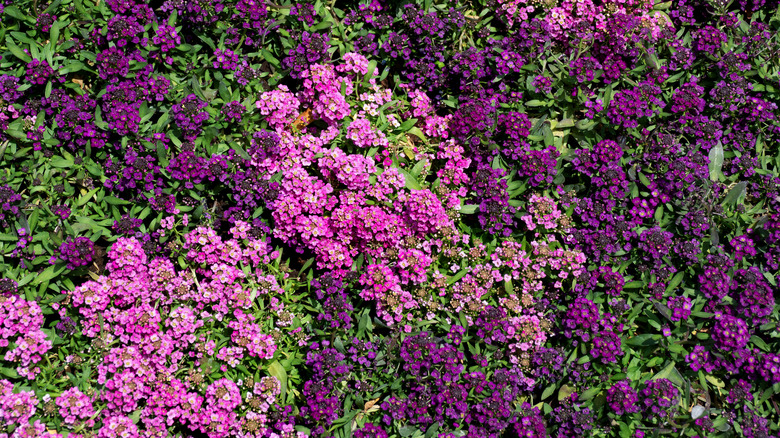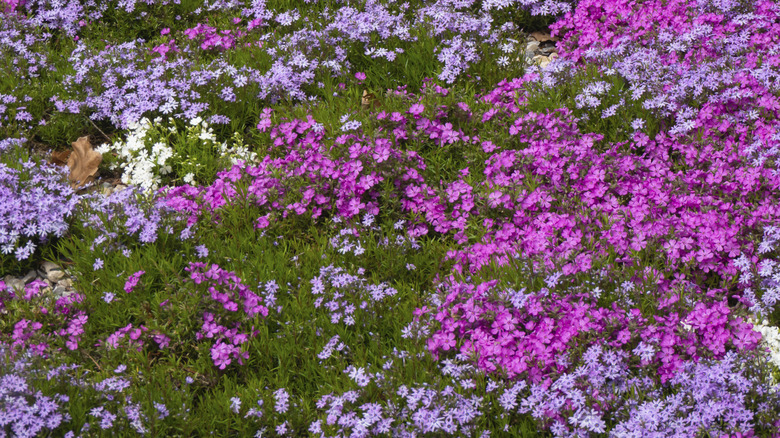What Are Tapestry Lawns And How To Create One In Your Yard
As the commitment to meticulously manicured lawns continues to wane, trends like ungardening and rewilding are gaining in popularity. These alternatives have a nature-infused zest to them, but unless you're taking the time to keep them in check, they also have the tendency to appear unkempt — if not downright messy. This is where a tapestry lawn steps in to bridge the gap and create a comfortable compromise between the two. Someone looking to eschew the monotony of a single shade of precisely cut green grass (and the high cost of money and time to maintain it) without inadvertently creating a backyard that looks like an overgrown nature preserve should take a close look at a colorful, low-growing, easy to maintain tapestry lawn.
Covered in a patchwork of small perennial blooms, the benefits of these lawns go beyond visual satisfaction — they're good for encouraging and supporting pollinators, and they're a durable option that can handle the wear and tear of an actively used yard. In short, a tapestry lawn is an excellent choice for those interested in climate-conscious gardening and also need a yard that can be used by a busy family.
Choosing plants for a tapestry lawn
The first thing to understand about a tapestry lawn is that there's more to ground cover plants than green grasses. Lots of low-growing plants produce colorful flowers, and it's these plants that come together to create a patchwork quilt of color that stays short and can be walked over. When picking out plants, go native to the best of your ability. Consider the layout of your lawn in terms of which areas receive full sun exposure, which are more shaded, and which hold the most amount of water when it rains. This information will help you determine which plants will thrive in each spot. For this project, you can think about growing these plants the way you would grass, so gather seed packets rather than seedlings.
Draw a rough outline of your yard so you can visualize the patchwork before you plant it. At the beginning of spring, use your lawnmower to cut whatever grass is present as low to the ground as possible. The intention is to put the grass at a disadvantage in order to give the new flowers an opportunity to sprout and grow. Then you can sow the seeds throughout by either mixing the different species (with similar cultural requirements) together or specifically creating patterns based on their individual colors. Water the lawn only if nature is being uncooperative and your region is experiencing an especially dry spring. Otherwise, leave it to blossom as it will.
How to mow a tapestry lawn
A backyard carpeted in brightly-hued low-growing flowers may sound all well and good to look at, but how does one go about maintaining that type of landscape? If you've done a good job choosing the appropriate plants, your tapestry lawn will require little in terms of fertilizer and watering. It will still need to be mowed, though. The mowing height will be higher than average — keep your lawn between 3 ½ and 4 inches tall. This tactic offers a slew of benefits, including denser coverage, stronger plants, and less mowing frequency.
Strive to cut a third of the lawn's height with each mow. This means letting it get a bit shaggy before heading out with the mower because in order to maintain a 4-inch tall lawn, you'll need to wait until it reaches a height of 6 inches before cutting it back. To avoid making some of the most common mistakes everyone makes when mowing the lawn, keep your blade sharp, refrain from mowing after a rainstorm, leave the clippings where they fall so they add nutrients back into the soil, and switch up the patterns and directions in which you move the lawnmower.


